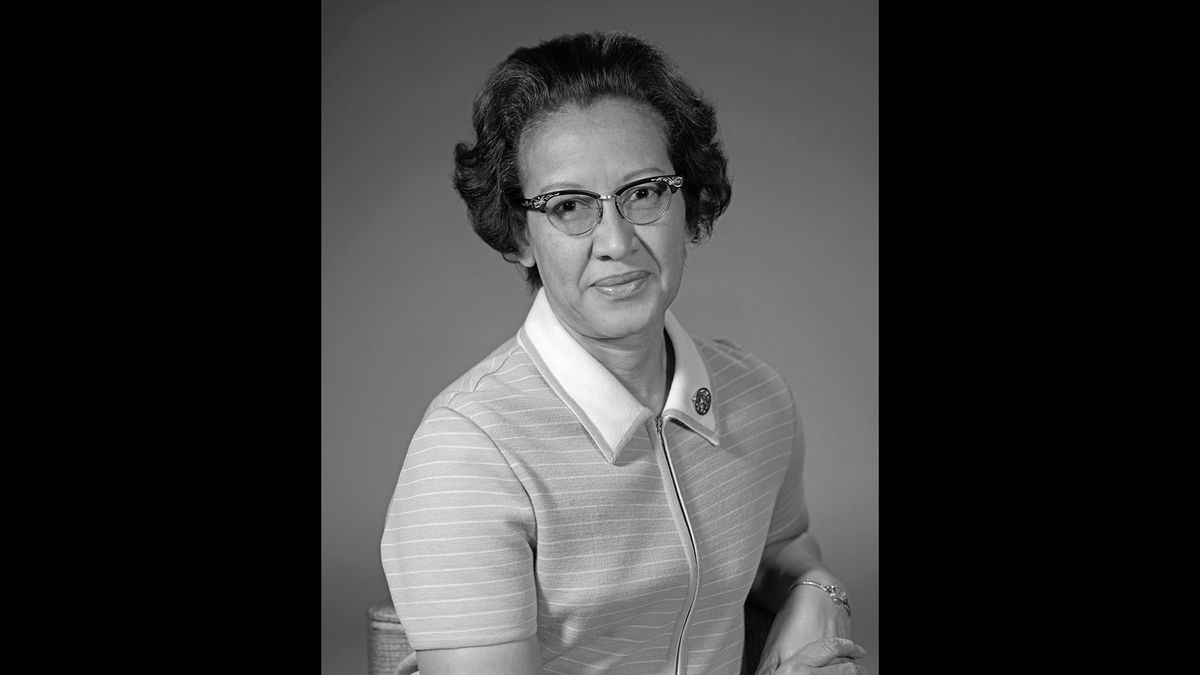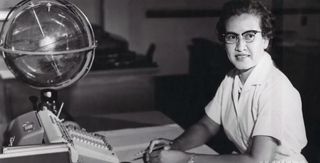Katherine Johnson: Pioneering NASA mathematician
Katherine Johnson played a pivotal role in the Space Race.

Katherine Johnson was a NASA mathematician who played a key role in several NASA missions during the Space Race, including calculating the trajectory needed to get the Apollo 11 mission to the moon and back.
As a black woman working for NASA in the 1950s and '60s, Johnson overcame social boundaries and racial discrimination.
Her impressive career was the subject of the 2016 book and movie "Hidden Figures."
Related: How 'Hidden Figures' came together: Interview with author Margot Shetterly
Johnson's road to NASA
Johnson was born in 1918 in White Sulphur Springs, West Virginia, the youngest of four children. From a very young age, she had a fascination with numbers, which would lead her to defy all expectations throughout her life. "I counted everything. I counted the steps to the road, the steps up to church, the number of dishes and silverware I washed … anything that could be counted, I did," said Johnson according to a NASA history article. said during an interview with NASA in 2015.
Johnson's hometown did not offer public schooling for black children past eighth grade, so her family moved 120 miles (193 kilometers) away so that she could attend high school. She graduated high school at just 14 and college at 18, securing degrees in both mathematics and French from the historically black West Virginia State College.
While in school, her potential was clear to her teachers. One of her professors, William Schieffelin Claytor, encouraged Johnson to become a research mathematician and created a geometry class just for her. After teaching for a few years, Johnson was accepted to West Virginia University's graduate math program, and in 1939, she became the first black woman to attend the school.
A year into her coursework, she left to raise her three daughters. Then, in 1952, a relative told her about an exciting new opportunity: The National Advisory Committee for Aeronautics (NACA), the predecessor to NASA, was hiring black women to solve math problems. Johnson applied right away. She was soon hired as a "computer" at the Langley Research Center, tasked with performing and checking calculations for flight tests.
"Before these big IBM mainframe computers came in [the NACA] really relied on human beings to do the math for calculating trajectories. Katherine really does play a role in that human computing lab," NASA historian Brian Odom told our sister publication All About History.
In addition to excelling at her work, Johnson was exceptionally curious and assertive, always questioning her colleagues and asking to be included in important meetings. When she started at NACA, Johnson and her black colleagues were required to work, eat and use restrooms separately from the white employees. But Johnson ignored the racial and gender barriers of the time and became the first woman in the Flight Research Division to be credited as an author on a research report.
"We needed to be assertive as women in those days — assertive and aggressive — and the degree to which we had to be that way depended on where you were. I had to be," Johnson said in 1999 of her time working for the NACA and later NASA.
NACA becomes NASA
In 1958, NACA became NASA. Johnson's time working for NASA would prove to be a more positive experience with regards to racial segregation given NASA's diversity policies. "Once NASA comes online in 1958 you see the build up of a lot of centres in the south. Today we'll think of Johnson Space Centre in Houston, Marshall Space Flight Centre in Huntsville, Alabama, and the Kennedy Space Centre in Florida, but there were other locations across the south too near New Orleans and South Mississippi. So basically what's happening is NASA is building a huge infrastructure in the time period from 1958 to 1963, at the build up for Apollo, in the Jim Crow segregated south," Odom said.
"The federal government, from the very beginning of this process, is committed to equal employment opportunity and that's something that John F Kennedy in March of 1961, with a new executive order, really makes a key part of this programme. So equal employment becomes a huge thing and for the first time in that executive order, we see that term "affirmative action". It's not just that you have to not discriminate, but you also have to have a positive plan for affirmative action, in which you demonstrate that you're taking the steps necessary to bring these jobs to African Americans," Odom added.
Notable achievements

With the Soviet Union launching the Sputnik satellite in 1957, the US was determined not to fall behind and so the Space Race began.
Johnson's passion was geometry, which was useful for calculating the trajectories of spacecraft. For NASA's 1961 Mercury mission, she knew that the trajectory would be a parabola, a type of symmetrical curve. So when NASA wanted the capsule to come down at a certain place, she was not deterred.
"You tell me when you want it and where you want it to land, and I'll do it backwards and tell you when to take off," Johnson said according to a NASA. Subsequent orbital missions were more complicated, with more variables involving the position and rotation of the Earth, so Johnson used a celestial training device to perform her calculations.
Johnson was tasked with calculating the trajectory for Alan Shepard's historic flight, during which he became the first American to reach space. She also confirmed the trajectory to send the first American into orbit around the Earth. By this time, NASA had begun using electronic computers to perform these tasks, but the machines could be a little temperamental. Before his Friendship 7 mission, astronaut John Glenn requested that Johnson personally recheck the calculations by hand. "If she says they're good, then I'm ready to go," Glenn said, according to Johnson’s recollection of the event.
The next challenge was to send humans to the moon, and Johnson's calculations helped sync the Apollo 11 lunar lander with the moon-orbiting command and service module to get the astronauts back to Earth. She also proved invaluable on the Apollo 13 mission, providing backup procedures that helped ensure the crew's safe return after their craft malfunctioned. She later helped to develop the space shuttle program and Earth resources satellite, and she co-authored 26 research reports before retiring in 1986.
Johnson's legacy
Johnson spent the following years speaking to students about her extraordinary career, encouraging them to pursue STEM education. "Some things will drop out of the public eye and will go away," she said at the NASA Trailblazers and Legends STEM Conference in Cape Canaveral, Florida in 2010. "There will always be science, engineering and technology. And there will always, always be mathematics. Everything is physics and math."
She and her colleagues became famous with the publication of "Hidden Figures" (William Morrow and Co., 2016) by Margot Lee Shetterly and the release of the blockbuster movie of the same name, which starred Taraji P. Henson, Janelle Monáe and Octavia Spencer as Johnson and her colleagues Mary Jackson and Dorothy Vaughan. The release of "Hidden Figures" made Johnson one of the most celebrated black women in space science and a hero for those calling for action against sexism and racism in science and engineering.
In 2015, President Barack Obama awarded Johnson the Presidential Medal of Freedom, America's highest civilian honor. And in 2016, the NASA Langley facility at which Johnson worked renamed a building in her honor: the Katherine G. Johnson Computational Research Facility.
In 2019, Johnson told her own story for young readers in a book called "Reaching for the Moon" (Atheneum Books for Young Readers).
"Every time engineers would hand me their equations to evaluate, I would do more than what they'd asked. I'd try to think beyond their equations. To ensure that I'd get the answer right, I needed to understand the thinking behind their choices and decisions," she wrote.
"I didn't allow their side-eyes and annoyed looks to intimidate or stop me. I also would persist even if I thought I was being ignored. If I encountered something I didn't understand, I'd just ask. … I just ignored the social customs that told me to stay in my place."
Johnson died on Feb. 24, 2020, at age 101. NASA Administrator Jim Bridenstine announced her death and promised that her legacy would be remembered.
"At NASA, we will never forget her courage and leadership and the milestones we could not have reached without her," Bridenstine said. "We will continue building on her legacy."
"She played a huge role in NASA throughout her career and is someone we (NASA) really look back on fondly," Odom said.
Additional information
You can learn more about Katherine Johnson’s work with NASA, or about her life and legacy with the New York Times. You can also educate your little ones about how remarkable Johnson was with this excellent picture book.
Bibliography
Johnson, K. (2020). Reaching for the moon: The autobiography of Nasa mathematician Katherine Johnson. Atheneum Books for Young Readers, an imprint of Simon & Schuster Children's Publishing Division.
Loff, S. (2016, February 25). Mathematician Katherine Johnson at work. NASA. Retrieved November 11, 2022, from https://www.nasa.gov/image-feature/mathematician-katherine-johnson-at-work
Loff, S. (2020, February 24). Katherine Johnson Biography. NASA. Retrieved November 11, 2022, from https://www.nasa.gov/content/katherine-johnson-biography
Shetterly, M. L. (2017). Hidden figures: The American Dream and the untold story of the black women mathematicians who helped win the space race. William Morrow, an imprint of HarperCollins Publishers.
Smith, Y. (2015, November 24). Katherine Johnson: The girl who loved to count. NASA. Retrieved November 11, 2022, from https://www.nasa.gov/feature/katherine-johnson-the-girl-who-loved-to-count
Wild, F. (2020, February 24). Katherine Johnson: A lifetime of Stem. NASA. Retrieved November 11, 2022, from https://www.nasa.gov/audience/foreducators/a-lifetime-of-stem.html
Join our Space Forums to keep talking space on the latest missions, night sky and more! And if you have a news tip, correction or comment, let us know at: community@space.com.
Get the Space.com Newsletter
Breaking space news, the latest updates on rocket launches, skywatching events and more!
